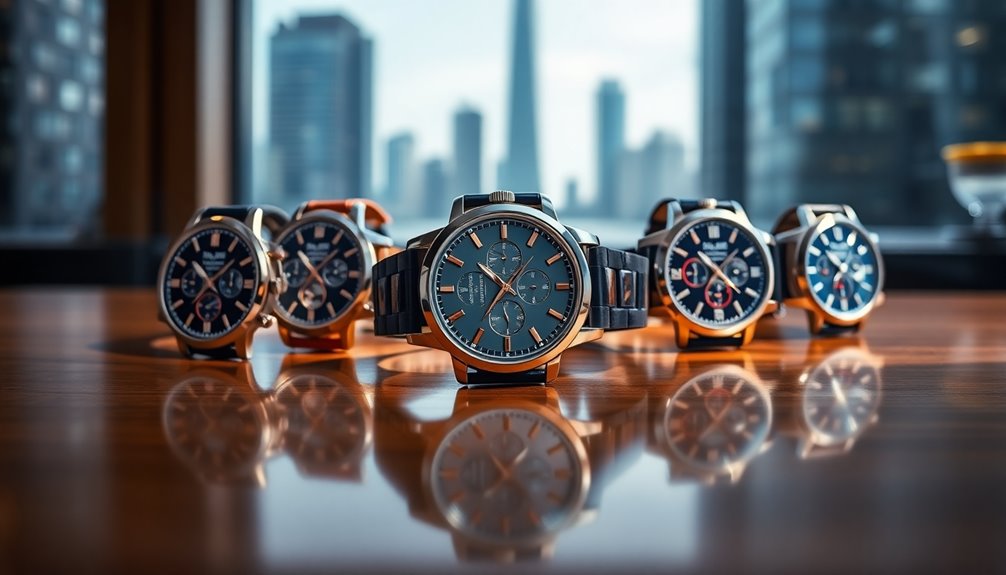Korean watch brands blend cultural significance with innovative designs, offering you a unique perspective on timekeeping. Notable names like Romanson and Julius balance elegance and functionality, while Amy Eujeny focuses on luxury and customization. You'll find options that reflect Korean heritage, like Harriot's handmade pieces. As younger generations seek authentic and sustainable styles, interest in these timepieces is growing. With affordable options such as Foce and Valence, there's something for everyone. Each brand tells a story that resonates with modern consumers. Stick around, and you'll uncover more about what makes these timepieces truly special.
Key Takeaways
- Explore notable Korean brands like Romanson, Julius, and Amy Eujeny, each offering unique designs and craftsmanship.
- Discover the cultural significance of watches in Korea, especially as gifts symbolizing milestones and commitments.
- Understand the market trends, including the growing demand for customization and eco-friendly materials in watch production.
- Experience the blend of traditional aesthetics with modern technology, as brands adapt to consumer preferences for digital integration.
- Anticipate a resurgence in interest for Korean timepieces, fueled by storytelling and collaborations with global fashion brands.
Overview of Korean Watch Culture

Korean watch culture flourished until the 1990s, with watches often gifted to men on their wedding days as symbols of commitment and status. This tradition underscored the significance of timepieces in Korean society, where a watch represented not just practicality but also a mark of esteem.
Traditional watches were crafted with great care, embodying both functionality and artistry, and many Korean watch brands thrived during this era.
However, as younger generations gravitated towards digital timekeeping, the popularity of traditional watches began to decline. This shift has impacted the prominence of many Korean watch brands, although a mix of small and larger companies continues to operate in the market.
Brands like Romanson and Tisell have managed to carve out niches with unique designs that reflect Korean aesthetics, showcasing craftsmanship that resonates with both the past and present.
Despite the challenges, there's potential for a resurgence in interest in traditional watches. Emerging brands are adapting to changing consumer preferences, which could reignite passion for these classic timepieces.
As you explore Korean watch culture, you may find a blend of innovation and tradition waiting to be rediscovered.
Notable Korean Watch Brands
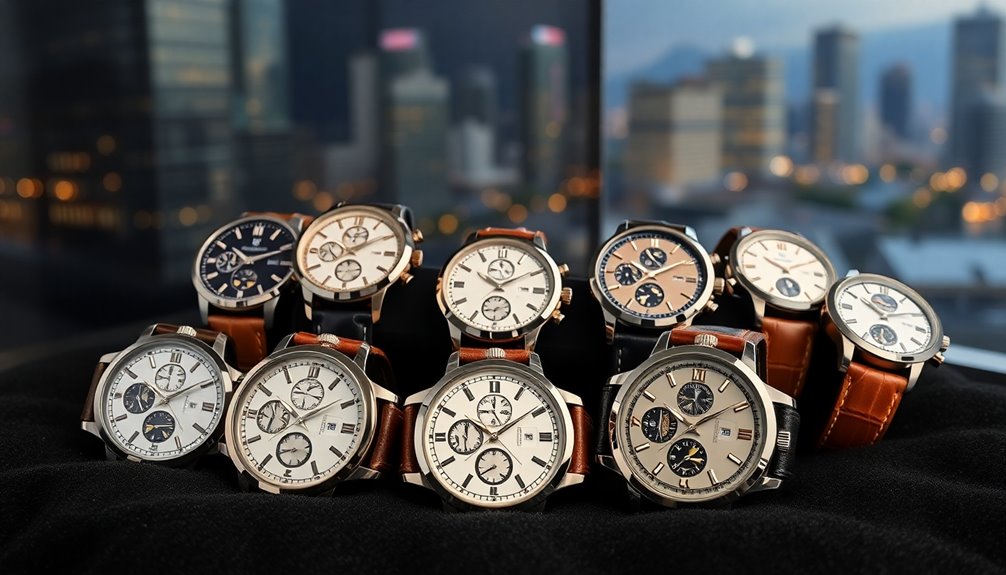
When you look at notable Korean watch brands, you'll see a mix of unique characteristics and market trends.
Brands like Romanson and Julius cater to a wide audience with their stylish yet affordable designs, while luxury options like Amy Eujeny focus on high-quality craftsmanship.
However, each brand faces its own challenges in standing out in a competitive market.
Unique Brand Characteristics
Exploring unique brand characteristics reveals a vibrant landscape of notable watch brands from Korea, each with its own distinct flair.
Romanson stands out with its classy designs that embody Korean aesthetics, utilizing Swiss movements to create versatile styles suitable for various occasions. This approach makes Romanson accessible to a wide audience, blending elegance with functionality.
On the other hand, Julius has gained international recognition since 2015 for its youthful designs crafted from high-quality materials. It offers a diverse range of watches, appealing to consumers seeking stylish yet affordable options, perfect for daily wear or special events.
For those who appreciate luxury, Amy Eujeny specializes in high-quality craftsmanship and unique customizable designs. This brand targets consumers interested in timeless pieces that not only serve as accessories but also may appreciate in value over time.
Additionally, other brands like Valence and Harriot bring their own unique elements, combining craftsmanship with cultural significance.
Whether you're drawn to the classic elegance of Romanson or the youthful energy of Julius, there's a Korean watch brand that perfectly matches your style and needs.
#
Market Trends and Challenges
The landscape of watch brands in Korea is evolving rapidly, presenting both opportunities and challenges. As younger generations lean towards digital timekeeping, traditional watch gifting has seen a notable decline. This shift creates competition for established brands, pushing them to refine their market positioning. Brands like Romanson and Julius are adapting by enhancing design and pricing strategies, making quality timepieces more accessible.
| Brand | Strategy | Target Market |
|---|---|---|
| Romanson | Design adaptation | Broad audience |
| Julius | Competitive pricing | Young professionals |
| Pitzmann | Unique designs | Niche collectors |
| Valerarch | Personalized models | Trend-conscious youth |
Microbrands like Pitzmann and Valerarch are rising, catering to specific niches with innovative timepieces. Consequently, innovations in design and marketing become essential for Korean watch brands to attract younger consumers and reignite interest in traditional timekeeping. By focusing on these elements, brands can navigate this competitive landscape, ensuring they stay relevant in a rapidly changing market.
Unique Features of Each Brand
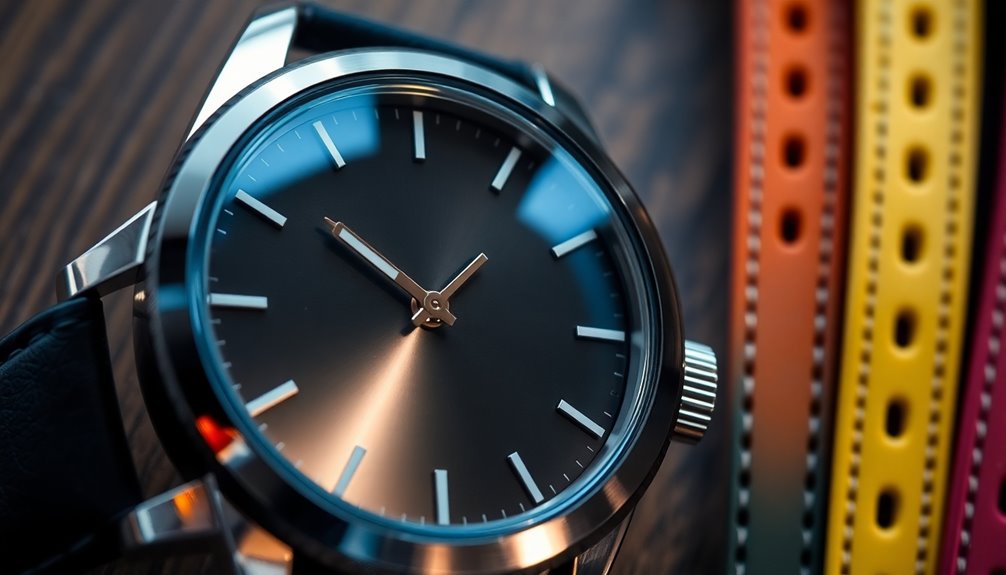
Korean watch brands each bring unique features that cater to diverse tastes and preferences.
For instance, Romanson watches stand out with their elegant designs that embody Korean aesthetics. Utilizing reliable Swiss quartz or mechanical movements, these watches are competitively priced, making them accessible to a wide audience.
On the other hand, Julius watches appeal to the youthful market with their stylish and sophisticated designs. They use high-quality materials like scratch-resistant glass and stainless steel, offering a variety of options including Quartz, Mechanical, and Kinetic watches—all at affordable prices.
If you're looking for luxury, Amy Eujeny watches specialize in unique designs and superior craftsmanship.
These timepieces not only allow for customization but also have the potential to appreciate in value over time, making them a worthwhile investment.
## Market Trends and Challenges

Watch sales in Korea are facing significant shifts as cultural practices and consumer preferences evolve. The traditional custom of gifting watches to men on their wedding days has declined, impacting both sales and the cultural significance of timepieces.
Younger consumers are increasingly gravitating toward digital timekeeping devices, further reducing engagement with established watch brands.
Here are some key market trends and challenges:
- Rise of digital alternatives: Consumers favor smartwatches and fitness trackers for their multifunctionality.
- Intensified competition: International brands are gaining ground, making it tough for local manufacturers.
- Limited online presence: Many Korean brands struggle with marketing strategies, affecting their visibility.
- Changing consumer values: Younger buyers prioritize brand authenticity and sustainability.
- Innovation opportunity: Despite challenges, there's room for new brands to innovate and capture market share.
To remain relevant, Korean watch manufacturers must adapt to these trends and tackle the fierce competition head-on.
Embracing digital marketing and enhancing online engagement could be the key to reviving interest in traditional timepieces amidst this shifting landscape.
Future Prospects for Korean Brands

A resurgence in interest for traditional timepieces is on the horizon as younger consumers start to appreciate the craftsmanship and heritage behind watchmaking. This trend bodes well for Korean watch brands, which are increasingly showcasing their unique designs rooted in cultural elements.
As you explore these brands, you'll notice the fresh wave of microbrands and independent watchmakers emerging, fostering innovation and diversity in Korea's horological landscape.
Digital engagement plays a key role in reaching this younger audience. Brands that prioritize an online presence and effective marketing strategies are likely to thrive. They're using social media platforms and e-commerce to connect with consumers who value authenticity and craftsmanship in their timepieces.
Moreover, the potential for collaborations with global fashion brands and cultural icons can greatly enhance the visibility of Korean watches. These partnerships not only broaden appeal but also reinforce the narrative of heritage designs and craftsmanship.
As the market evolves, you can expect Korean watch brands to gain recognition both domestically and internationally, solidifying their place in the competitive world of horology. The future looks bright, and you won't want to miss what's next!
Popular Affordable Options
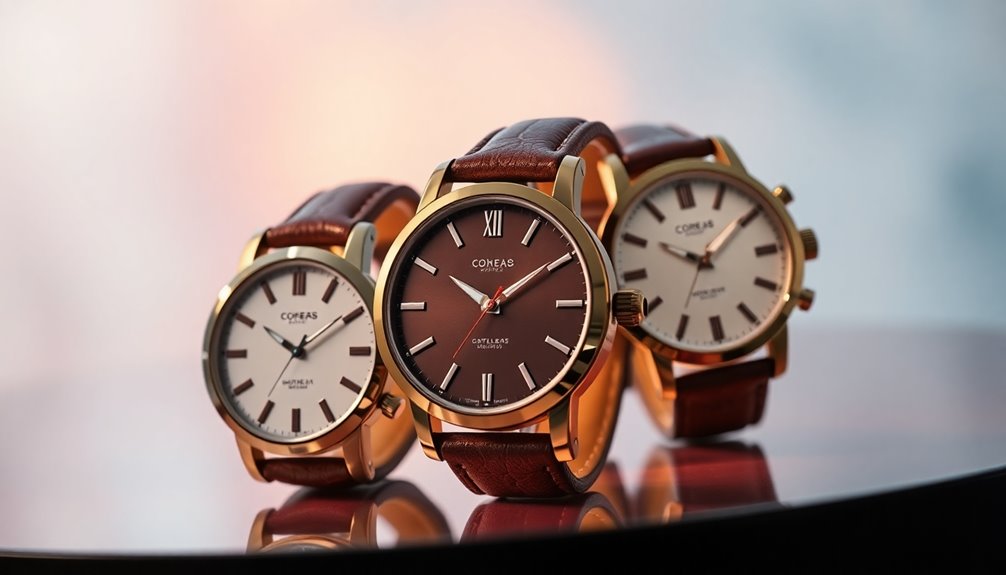
Exploring the world of affordable timepieces reveals a vibrant selection that caters to diverse tastes without breaking the bank.
If you're searching for a popular Korean watch brand, you'll find plenty of options that don't compromise on style or quality. Here are some standout choices:
- Julius: Offers stylish watches priced between under 300,000 VND and around 4 million VND—an affordable choice for fashion-conscious consumers.
- Romanson: Features elegant designs powered by Swiss movements at competitive prices, ensuring accessibility for everyone.
- Foce: Established in 1997, specializes in budget-friendly fashion watches, with some premium options that appeal to cost-conscious buyers.
- Harriot: Creates handmade timepieces that blend cultural significance and craftsmanship while keeping prices affordable.
- Valence: Known for high-quality materials and exquisite craftsmanship, with a price point around 2 million VND, making it a competitive option among Korean brands.
These brands prove that you can enjoy stylish and reliable timepieces without spending a fortune.
With such diverse offerings, there's a perfect watch waiting just for you!
Craftsmanship and Design Elements
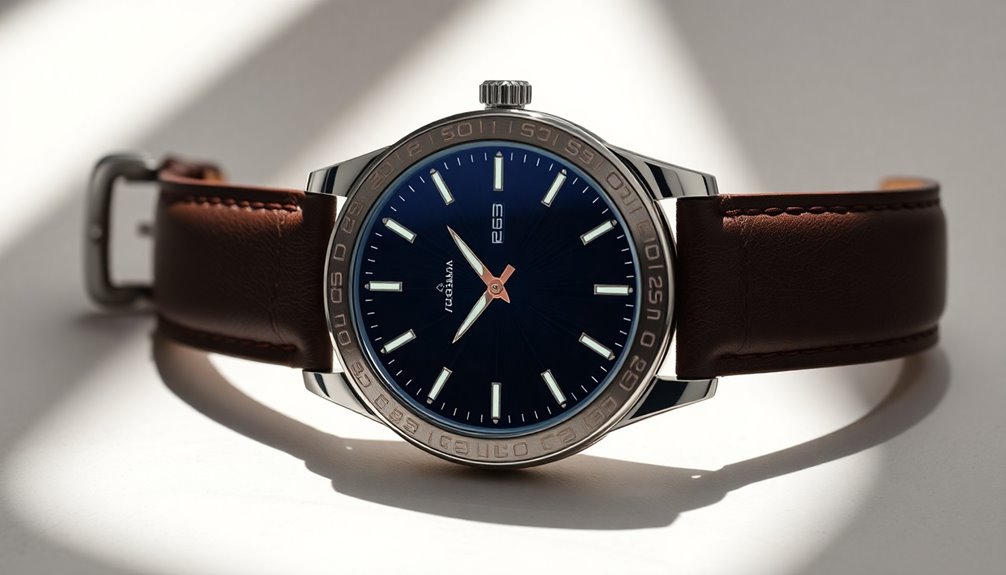
In the domain of Korean timepieces, craftsmanship and design elements stand out, showcasing a unique blend of tradition and modernity. Brands like Romanson and Valence exemplify this with their elegant designs that reflect Korean aesthetics. They use high-quality materials such as stainless steel and sapphire glass, ensuring both durability and style.
If you're looking for luxury, Amy Eujeny specializes in customizable options, emphasizing timeless quality and unique designs crafted from premium materials.
On the other hand, Harriot focuses on handmade timepieces inspired by Korean landmarks, highlighting artisanal craftsmanship that connects each piece to its cultural roots.
For a younger audience, Julius offers a range of elegant designs featuring scratch-resistant glass and reliable Japanese movements. Each of these brands combines functionality with artistic influences, creating timepieces that aren't only practical but also serve as expressions of cultural heritage and personal style.
Ultimately, when you explore Korean watches, you'll find a rich tapestry of craftsmanship and design that elevates your everyday experience. These timepieces are more than just tools for telling time; they're elegant statements of identity and artistry.
Cultural Significance in Timekeeping
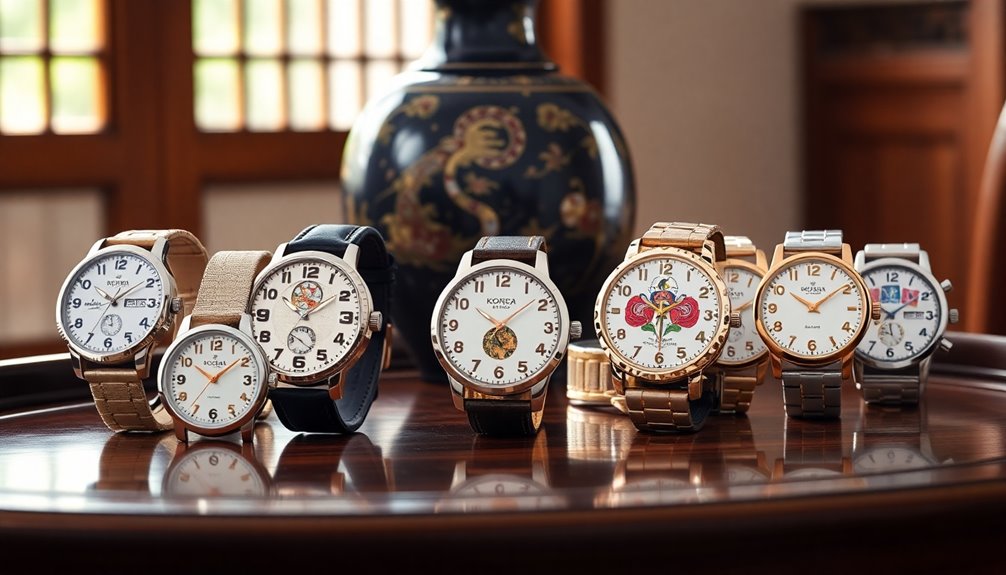
Korean watches carry deep cultural significance, reflecting traditions that go beyond mere timekeeping. For many, these timepieces symbolize milestones and meaningful moments in life, particularly in the context of traditional watch gifting. On wedding days, it's customary for men to receive a watch, marking a rite of passage and commitment.
However, as younger generations lean towards digital devices, this age-old practice faces decline.
Despite these changes, Korean watch brands are innovating by incorporating cultural elements into their designs. Take Harriot, for example, which draws inspiration from iconic Korean landmarks. This blend of heritage and modernity encourages a renewed interest in watches as meaningful accessories.
Consider these aspects of cultural significance in Korean timekeeping:
- Traditional watch gifting remains a cherished custom.
- Cultural elements enrich design and storytelling.
- Microbrands promote personal expression and identity.
- Craftsmanship reflects a desire for quality and authenticity.
- Potential resurgence in traditional watches shows hope for the future.
As you explore the world of Korean watches, you'll find that they're more than just instruments for telling time; they're reflections of identity and tradition.
Frequently Asked Questions
What Is the Most Popular Watch Brand in Korea?
When you're looking for the most popular watch brand in Korea, you can't overlook Romanson. Established in 1988, it stands out for its elegant designs and Swiss movements.
If you prefer something trendy and affordable, Julius is a great choice, especially among younger consumers.
Foce offers budget-friendly options, while Harriot brings unique, handcrafted pieces inspired by Korean culture.
Each brand appeals to different tastes, ensuring you'll find something that suits your style.
Which Is the No 1 Watch Brand in World?
Imagine you're at a gala, and everyone's wearing exquisite watches. You notice a guest flaunting a Rolex, instantly catching everyone's attention.
Rolex is often hailed as the No. 1 watch brand in the world, thanks to its unmatched luxury and prestige. With a valuation of about $9.1 billion, it leads the luxury market, outshining competitors like Omega and Patek Philippe.
Its reputation for quality and craftsmanship keeps it at the top.
What Is the Most Recognized Watch Brand?
When it comes to the most recognized watch brand, many would argue it's Rolex.
You see, Rolex has built its reputation on luxury, precision, and status, making it a household name worldwide. With its iconic designs and a strong association with success, Rolex stands out among competitors.
Other brands, like Omega and Patek Philippe, also hold significant recognition, but Rolex consistently leads the pack regarding global brand awareness and prestige.
Where Is Julius Watch From?
If time is a river, Julius watches flow from the heart of South Korea, specifically Seoul.
Established in 2001, this brand quickly made waves in the watch industry. By 2015, it expanded its reach beyond Asia, enchanting customers in countries like the US, Canada, and Mexico.
Julius combines youthful elegance with award-winning designs, making it a favorite among watch enthusiasts.
Conclusion
To sum up, the Korean watch industry is thriving, with a remarkable growth rate of 15% over the past five years. This booming market showcases not just timepieces, but also a rich culture that intertwines craftsmanship and innovation. So, whether you're drawn to sleek designs or unique features, there's a Korean watch out there waiting for you. Embrace the blend of tradition and modernity—your wrist will thank you for it!
